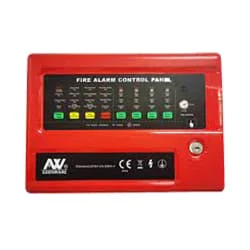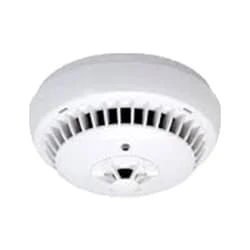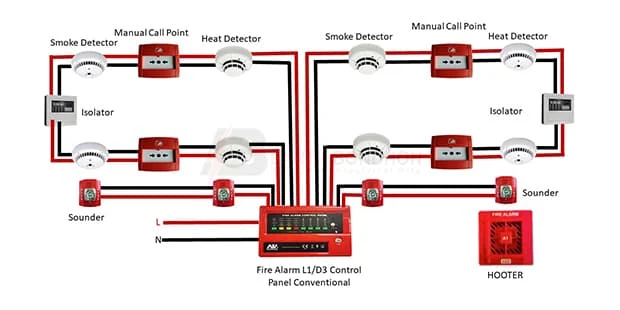What is conventional Fire Alarm System:
The electronic & electrical system that can detect fire-related accidents and can alert or notify people, is called a Fire alarm and detection system. The fire alarm system is very important for safety in factories, in fact, houses, and residential buildings. Houses also have fire alarm systems. The initiating device, notification device, and control panel are the main basic components of a panel Fire system. types of Fire Alarm systems.
Diagram of Fire Alarm System Wiring:
Components Need for this Project:
You can get the components from any of the sites below:
- Panel Conventional [See Buy Click Amazon]
- Hooter [See Buy Click Amazon]
- Smoke Detector [See Buy Click Amazon]
- Manual Call Point [See Buy Click Amazon]
- Heat Delector [See Buy Click Amazon]
Read Also:
- Resistor
Components used to make the Fire Alarm System:
01. Panel Conventional
 |
| Fig 2: Panel Conventional |
02. Hooter
 |
| Fig 3: Hooter |
03. Smoke Detector
 |
| Fig 4: Smoke Detector |
A Smoke Detector is an Electronic Fire-Protection Device That Automatically Senses The Presence of Smoke, as a key indicator of fire, And Sounds Like a Warning to Building Occupants. Commercial And Industrial Smoke Detectors Issue a Signal To a Fire Alarm Control Panel as Part of a Building's Central Fire Alarm System. Household Smoke Detectors, or Smoke Alarms, Issue an Audible And/or Visual Alarm locally From The Detector Itself. They Can be Battery-Powered Single Units or Several Interlinked Hardwired Devices Backed up by Batteries.
04. Manual Call Point
 |
| Fig 5: Manual Call Point |
A Manual Call Point is a Device That Enables Personnel to Raise an Alarm in the Event of a Fire Incident by Pressing a Frangible Element to Activate the Alarm System. A Fire Alarm Call Point Should be Installed at a height of 1.4m Above Floor Level at Easily Accessible And Conspicuous Positions. Manual call Points, Often Known as 'Break-Glass' Call Points, Enable a Person Who Discovers a fire to Operate the Fire Warning System and Immediately raise the Alarm to Warn other People on the premises. Manual Call Points are Normally Positioned at exit Doors.
05. Heat Delector
 |
| Fig 6: Heat Delector |
A Heat Detector is a Fire Alarm Device Designed to Respond When The Convected Thermal Energy of a Fire Increases The Temperature of a Heat-Sensitive Element. The Thermal Mass and Conductivity of The Element Regulate The Rate of The Flow of Heat Into The Element. All heat Detectors have this Thermal lag. A Heat Detector is a Property-Safety Sensor That Responds to Very High Temperatures That are Only Present During Fires. Standalone heat Detectors are Often Used in rooms Where Smoke Detectors may Cause False Alarms. Heat sensors Usually take Longer to Respond to fire Than Smoke Detectors.
Thank You for visiting the website. Keep visiting for more Updates.


Post a Comment
Do leave your comments